
Ref: z263144m
Relay technology
The relay was invented more than 160 years ago. During the last 50 years it has undergone considerable change, the most obvious of which is its reduction in size. Using new and advanced contact materials, the switching capacity has either been maintained or increased and the use of new plastic materials has improved the insulation properties. Stateoftheart technology and precision engineering has led to increased relay sensitivity, ie the ratio of input coil power to switching capacity.
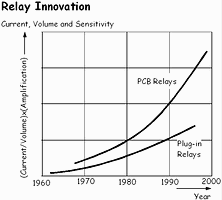
Typical applications for relays include laboratory instruments, telecommunication systems, computer interfaces, domestic appliances, airconditioning and heating, automotive electrics, traffic control, lighting control, building control, electric power control, business machines, control of motors and solenoids, tooling machines, production and test equipment.
Relay functions
Relays are electromagnetically operated switches. An actuating current on a coil operates one or more galvanically separated contacts or load circuits. The electromechanical relay is a remote controlled switch capable of switching multiple circuits, either individually, simultaneously, or in sequence.
The primary function of a relay is:
* The galvanic separation of the primary or actuating circuit and the load circuits
* Single input/multiple output capability.
* Separation of different load circuits for multipole relays.
* Separation of AC and DC circuits.
* Interface between electronic and power circuits.
* Multiple switching functions, e.g. delay, signal conditioning.
* Amplifier function.
The capability to operate the power contacts and switch high currents with low input power on the primary side provides the amplifier function of the relay. However, unlike the transistor, the relay is not an analog amplifier but a 'digital' (01, ONOFF) type amplifier. Input signals can be amplified by a factor up to 105 or reduced as in signal relay applications.
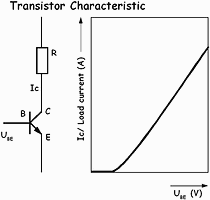
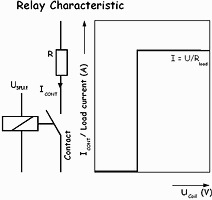
Relay classification
Relays have the same subsystems and principals of operation regardless of whether they are electromechanical or electronic, or designed to switch signal or high power loads.
These principal functions are:
* Conversion of an electrical input signal on the primary side to an intermediate and non-electric physical signal.
* Reconversion of this non electric physical signal to operate a switching element (secondary side) such as contacts which switch and conduct electrical current (output, load current).
* The use of the non-electric signal between primary and secondary side provides the necessary galvanic separation between input and output circuits.
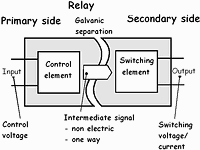
These basic relay functions can be achieved in very different ways. The resulting variety of designs are classified in several groups:
Electromechanical relays electronic relays
According to the nature of the secondary switching element, basic relay types are:
Electromechanical relays
In this case the switching element is a mechanical contact. This is the most widely used type of relay design. Standard yoke type designs as well as reed relays and others are part of this group.
The principal internal functions of the electromechanical relay are:
* Conversion of electrical current (input, coil current) to a magnetic field.
* Conversion of the magnetic field into a mechanical force.
* This force operates the contacts (secondary side).
* Contacts switch and conduct electrical current (output, load current).
Electronic relays:
This type of relay uses electronic switches such as transistors, triacs, etc as the main switching element.
Electromagnetic relays other designs:
Relays can also be classified according to the nature of the intermediate signal between the primary side and the switching element. For example:
Electromagnetic relays - a magnetic field generated by the input signal operates on the mechanical contacts. Examples are the standard yoke type relay or the reed relay.
Optocouplers - in this type of 'relay' the electronic switching element is controlled optically. On the primary side an optical signal is transmitted by means of a light emitting diode, while a phototransistor acts as a receiver and controls the switching element. In this case the optical connection provides the galvanic separation.
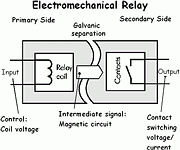
Other electronic designs - the signal from the primary side also can be transmitted by other means, eg by frequency modulation or capacitive effects. These are techniques used by solid-state relays.
Other more exotic relay designs are:
Thermoelectric relays - here the input energy on the primary side heats a bimetal part which actuates the contacts mechanically.
Piezo relays - in this type of design the contacts are operated mechanically by the piezoelectric effect.
Signal relays power relays contactors
Relay designs can also be divided according to their switching capacity ie
Signal relays: signal switching relays cover signal, data and voice switching applications up to approximately 2 A resistive load. Typical applications are measurement systems, computer interfaces and telecommunications. Designs for signal relays include standard yoke type relays, reed relays and solid-state relays.
Power relays: According to IEC 255, these are relays which switch up to 600 V and 100 A. The high current area overlaps the switching range of contactors. Generally, power relays switch up to 16 A for PCB types and up to 30 A for industrial types. The most common design for power relays is the standard yoke type relay. For some applications solid-state power relays may be used.
Contactors: Although contactors are not strictly relays they have the same design principles. Like relays, they are remote-controlled switches. The difference is the considerably higher input power consumption, higher switching capacity, and larger size.
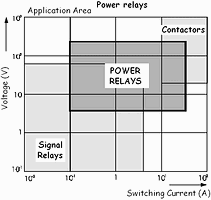
Miniature, PCB, industrial relays etc
Power relay types can also be divided according to their mechanical features ie miniature, PCB, industrial etc. The term miniature refers to physical size. However, as relay technology has used this term for some time it does not necessarily give an indication of absolute size.
PCB power relays are designed for mounting on printed circuit boards. Industrial relays are typically used in switching cabinets by control panel builders.
As you can see, there is a wide range of different electromechanical relay types to suit almost all applications. However, having such a large choice can make selection difficult. Design principles throughout the different relay classifications are the same and basic characteristics and technological aspects are interchangeable.
For more information contact local Tyco Electronics distributor, Arrow Altech Distribution. Any enquiries can be addressed to Neil Abrahams, 011 923 9600, [email protected]
| Tel: | +27 11 923 9600 |
| Email: | [email protected] |
| www: | www.altronarrow.com |
| Articles: | More information and articles about Altron Arrow |

© Technews Publishing (Pty) Ltd | All Rights Reserved